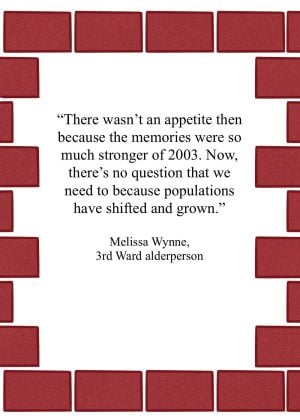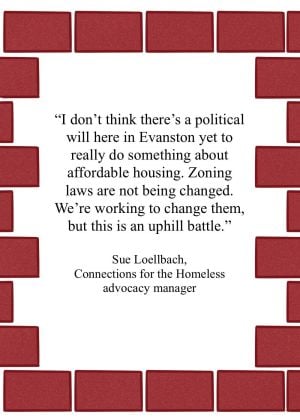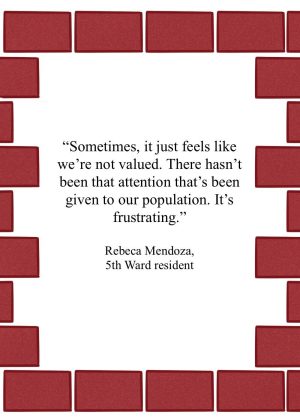In Focus: As Evanston braces for its first ward redistricting in nearly two decades, residents say changing demographics speak to a lack of affordable housing
June 10, 2022
Growing up in Evanston’s 2nd Ward, Darlene Cannon lived in a mostly Black neighborhood.
Since she was born in Evanston more than five decades ago, she has lived within the same four-block radius. Her community was built on support, she said, where children would always play together outside.
But the demographics of her community have fundamentally changed. For the first time in decades, the percentage of white adults in the 2nd Ward was higher than any other demographic, according to the 2020 census. Cannon said an influx of new residents has changed her neighborhood’s dynamic to one where many are “not interested in building community.”
“Before, we had community in the sense that we knew our neighbors, we knew their children, we knew who their dogs were and we looked out for each other,” Cannon said. “(Now) you don’t know who your neighbors are.”
5th Ward resident Kemone Hendricks, who has lived in the city since she was about five years old, said she’s also seen demographic changes in her neighborhood.
Historically, the 5th Ward has been home to the city’s highest percentage of Black residents due to Evanston’s history of racial housing segregation and discriminatory redlining policies. But over time, Black families who have owned homes in the 5th Ward for generations have been priced out, Hendricks said.
The percentage of Black adults in the 2nd and 5th wards has declined since the turn of the century, dropping from 50% and 51%, respectively, in 2000 to 32% and 38% in 2020.
“It almost seemed like it happened overnight, but I don’t think it did,” Hendricks said. “To a lot of people, you woke up and it’s just not the same neighborhood you lived in anymore.”
As Evanston plans to redraw its ward boundaries for the first time since 2003, residents are sounding the alarm about how changing demographics reflect the relationship between affordable housing and gentrification.
Taking up the scissors
According to the 2020 census, Evanston grew by 3,624 residents, a near 5% jump from 2010, bringing its population to 78,110.
Evanston isn’t required to redistrict unless its population dips below 70,000 or exceeds 90,000. But Nicholas Cummings, Evanston’s corporation counsel, said the city can redistrict its nine wards for other reasons, such as uneven population shifts.
“The city actually has a compelling reason right now in the sense that we have a really large deviation in terms of population in the various different wards,” Cummings said.
If Evanston redistricts, its wards are required to be nearly equal in population. Cummings, who serves as an advisor to the city’s Redistricting Committee, said this ensures equality in resident voting power.
Equality is measured by calculating the extent each ward’s population deviates from the average population of all nine wards. To comply with state law, the combined total of the wards’ deviations should ideally be below 10%, though deviations up to 16.4% are legally acceptable under some circumstances.
Evanston’s total population deviation for 2020 was 20.4%, exceeding that mark and triggering the decision to redistrict.
Ald. Jonathan Nieuwsma (4th), chair of the Redistricting Committee, said he doesn’t anticipate drastic changes to the ward map. At its inaugural May 10 meeting, the committee agreed to alter existing ward boundaries rather than draw a new map from scratch.
While Evanston hasn’t yet set its criteria for this round of redistricting, Nieuwsma said it likely will do so at a June 28 meeting. The 2003 redistricting criteria included the minimization of voter confusion and preservation of traditional Evanston neighborhoods.
Ald. Melissa Wynne (3rd), a member of the committee, said City Council aims to respect existing neighborhoods and block clubs when redistricting. As was the case in 2003, she said her co-committee members also want to respect manmade and natural geographical boundaries — like railroad lines, major streets and the canal — when redrawing the boundaries.
“You’re actually keeping contiguity of neighborhoods together, contiguity of interests, of people who know each other well,” Wynne said. “They can band together on issues if they want to and come to (the council), which happens all the time.”
Growing pains
“Hallelujah!”
That was how Wynne reacted in 2010 when the council learned Evanston was not required to redraw ward boundaries. Her colleague, former 5th Ward Ald. Delores Holmes, called the redistricting process “a nightmare” at the time.
The last time Evanston redistricted and reapportioned its nine wards was in 2003, following the release of 2000 census data. Residents and city leaders criticized ward redistricting proposals in the early 2000s because of the potential to dilute Black voters’ voting power in Evanston.
Evanston has three majority-minority wards: the 2nd, 5th and 8th. The city is required to ensure historically marginalized residents have access to civic participation under the Voting Rights Act of 1965. Advocates for maintaining a cohesive Black voting bloc in those wards say Evanston’s Black population qualifies as a protected voting bloc, arguing against maps that would violate the law.
After months of debate, the council approved a new map that took effect Aug. 1, 2004. Submitted by former 2nd Ward Ald. Lionel Jean-Baptiste, the map maintained the 2nd and 5th wards as majority-minority.
Following the release of 2010 census data, community members began discussing the possibility of ward redistricting, but the council voted against it in January 2012. With the total population of Evanston only growing by 247 people since 2000, the majority of councilmembers said redistricting would be a painful, expensive and unnecessary process.
“There wasn’t an appetite then because the memories were so much stronger of 2003,” Wynne said. “Now, there’s no question that we need to because populations have shifted and grown.”

Wynne is the only sitting councilmember who was present on the dais in 2003.
Today, she faces a new issue: redrawing the boundaries of the 3rd Ward, which has the largest population in the city by nearly 600 people. She said there are straightforward changes that wouldn’t disrupt a neighborhood, like moving a couple blocks from the 3rd Ward’s north end into the underpopulated 1st Ward.
Ald. Devon Reid (8th) made the initial council referral to create the Redistricting Committee and now serves as one of its members. He said he was interested in redistricting because some wards are gerrymandered in a way that splits existing communities. For example, he said the 1st and 7th Wards divide NU’s campus in two.
At the committee’s inaugural meeting, Reid made the case for part of South Evanston, including the 8th Ward, to extend to the lakefront. They said a working class community like the 8th Ward, one that contains one of the largest populations of Black residents in the city, should have some ownership over the lakefront through their legislative representative.
As it stands, the 1st, 3rd and 7th wards are the only ones that border Lake Michigan. Extending toward the lakefront, Reid said, would also help shrink the 3rd Ward’s population and expand the 9th Ward, which currently has the lowest population.
“We should try to, instead of breaking (communities with similar interests) up, create a system where they’re spread across wards but a strong voice in that ward,” Reid said.
Price tag problems
Following the 2008 stock market crash, Evanston experienced a housing crisis that Ald. Bobby Burns (5th) said displaced residents and converted many single-family homes into multiunit residences.
Burns, who is also on the Redistricting Committee, said the 5th Ward has recently seen a higher percentage of renters than any other ward in Evanston.
“The lack of affordable housing is a tremendous driver of displacement,” Burns said. “In the 5th Ward, the shift from owner-occupied to renter-occupied makes a difference because you have less movement from owner-occupied than you do renters.”
Hendricks, the 5th Ward resident, said she rents property because she can’t afford to buy a home in Evanston. Although she is the mother of an Evanston Township High School student and an alum, she said purchasing a home would be financially unsustainable.
“Evanston, as a place that screams diversity, screams affordable housing, doesn’t have actual really affordable housing,” Hendricks said. “These homes that a lot of Black families have owned for such a long time are now being priced out.”
Mayor Daniel Biss said Evanston should view its shrinking Black population as a “real wakeup call.” He said one example of the city’s efforts to expand affordable housing was its strengthening of the Inclusionary Housing Ordinance in 2018, which tightened requirements for affordable on-site units and incentivized their creation.
But Biss said those efforts alone won’t solve Evanston’s problem.
Evanston residents earning below the median income, particularly households with annual incomes below $50,000, are likely to face a hard time finding housing that is “truly affordable,” said Sue Loellbach, advocacy manager for Connections for the Homeless. For low-income residents, including minimum wage and part-time workers, she said finding housing can be even more difficult.
“The goal is to try to find a place that they can afford,” Loellbach said. “And very often, that just is not possible here.”
Loellbach said there’s been a recent increase in luxury units in Evanston, specifically in downtown areas. Evanston is experiencing a housing boom with rising prices, she said.

The city also has restrictive zoning that makes it difficult to create more affordable housing, Loellbach said. For example, if a landlord wants to add a unit to their property, they have to add parking as well, which she said can be prohibitive as there often isn’t enough space for both.
Loellbach also mentioned the three-unrelated rule, colloquially known as the Brothel Law, a long-debated zoning ordinance that prevents more than three unrelated people from living together. Those who support the three-unrelated rule typically hope to safeguard their communities from Northwestern students seeking off-campus housing, Loellbach said, and it’s unfair to impose that rule citywide.
If anything, Loellbach said the encroachment of student housing in single-family neighborhoods is partially due to limited availability near campus. Instead of “villainizing” the student body, she said new housing needs to be created, with the University and the city working together toward a solution.
“I don’t think there’s a political will here in Evanston yet to really do something about affordable housing,” Loellbach said. “Zoning laws are not being changed. We’re working to change them, but this is an uphill battle.”
‘A double-edged sword’
For many 5th Ward residents, the now-closed Foster School was the community’s beating heart.
Nearly all Foster students were Black before integration, but District 65’s desegregation proposal turned Foster into a magnet laboratory school in 1967, requiring students to be admitted by application. The magnet school offered incentives encouraging white families outside the ward to enroll their children, and some Black students who were previously attending the school were displaced.
Eventually, the magnet program relocated, and Foster School closed altogether in 1979. The 5th Ward hasn’t had a neighborhood school since.
In March, the Evanston/Skokie School District 65 Board of Education voted unanimously to build a new school in the 5th Ward, which could open as soon as the 2024-25 school year.

Hendricks said the situation is a “double-edged sword.” On one hand, she called the new school a form of restitution, particularly for the city’s decades-long practice of busing 5th Ward students to schools in other wards. However, she said the new school could also contribute to gentrification in the ward.
“Now that the school is being built, and the obvious gentrification that’s already been going on in the 5th Ward, is this really going to be a safe space for Black families anymore?” Hendricks said.
Hendricks said her two children attended Walker Elementary School, just outside the 2nd Ward across the canal, and Chute Middle School, located in the 9th Ward.
When her kids went to Walker, Hendricks said she had to drive them to school every day due to her work schedule. Sometimes, that meant pulling in her mother or aunt to drive them when she had a work conflict. She said getting her children to school felt like a “community effort.”
“If I had this option that’s about to be available to families that live in the 5th Ward, it would have made my life 10 times easier,” Hendricks said.
Burns said the lack of a neighborhood school has made a difference in the housing market. He said he thinks the promise of a 5th Ward school would encourage residents, particularly those with children, to move to the neighborhood and stick around.
Biss said the city has a responsibility to ensure its policies expand affordability in the 5th Ward, allowing those with roots in the neighborhood to stay while drawing in new residents.
“The city, through its affordable housing policymaking, is really a critical partner of the school district in ensuring (gentrification) does not occur,” Biss said.
A citywide shift
Mariana Bojorquez, Evanston Public Library’s Latino engagement librarian, said a co-worker of hers argued years ago that Evanston would see an increase in immigrants and Spanish-speaking residents by 2020, and the city needed to prepare for this change.
Using previous census data to inform her arguments, her colleague advocated for more bilingual materials in city documentation and hiring multilingual staff to serve as translators, Bojorquez said.
Evanston’s Hispanic population increased from 8% in 2010 to 10% in 2020 — the largest percentage point growth during that time frame for any racial or ethnic demographic. Bojorquez said the library has already discussed adding a translation budget, and she hopes the city also responds appropriately to the increase in residents who don’t speak English.
5th Ward resident Rebeca Mendoza said this demographic change isn’t specific to Evanston, and the city will likely continue to see increases. America’s Hispanic or Latine population nationwide grew 23% into 2020, accounting for more than half the country’s total population growth.

Rebeca Mendoza said there are multiple generations of Latine families in Evanston with legacies rooted in the city’s history. Many Latine residents feel invisible, she said, in part because the city hasn’t responded to the demographic increase.
“Sometimes, it just feels like we’re not valued,” Rebeca Mendoza said. “There hasn’t been that attention that’s been given to our population. It’s frustrating.”
City Clerk Stephanie Mendoza said it’s important to prioritize city funding of culturally relevant services to non-English speakers. Some of these services could include translations at service desks in city buildings and translators at City Council meetings.
Stephanie Mendoza was sworn in as Evanston’s first Latine elected official in April 2021, and less than a year later, Ald. Juan Geracaris (9th) became Evanston’s first Latino councilmember.
“It’s about representation,” Stephanie Mendoza said. “It’s feeling like we have a voice when it comes to the issues that affect our young children and our community and access to services.”
Drawing up a plan
At its inaugural meeting, the Redistricting Committee unanimously voted to start redrawing ward boundaries, setting a goal of May 2023 for approval of the finalized map.
Over the next year, the committee will host meetings to engage residents, including a virtual kickoff town hall this summer that will also be available in Spanish. Nieuwsma said the council hopes to release proposed maps by January 2023 and vote sometime after the 9th Ward special election in April 2023.
Until then, residents plan to make their voices heard in the redistricting conversations. While the first Redistricting Committee meeting saw low attendance, with no residents in attendance and one written public comment, Hendricks said stakeholders across the city are invested in redistricting.
Cannon said she doesn’t think many residents are aware that conversations around redistricting have begun, but she plans to attend meetings and learn more about the proposed changes to ward boundaries. The 2nd Ward has grown more than the four surrounding wards, meaning there will likely be changes to its borders.
The ward she grew up in used to be an affordable place for Black and brown people to live, but Cannon said that reality is becoming less and less feasible. She said she’s worried for longtime residents who want to buy a house in the place they call home, but can’t afford to do so.
“The more the neighborhood becomes gentrified, the less affordable it becomes,” Cannon said. “In many cases there are scenarios where Black families get in a bind, and we as a city aren’t doing things to keep ahold of those homes.”
Email: isabellesarraf2022@u.northwestern.edu
Twitter: @isabellesarraf

